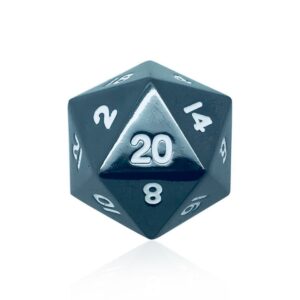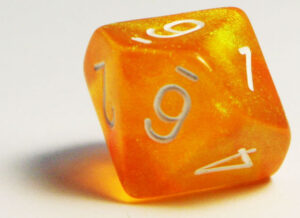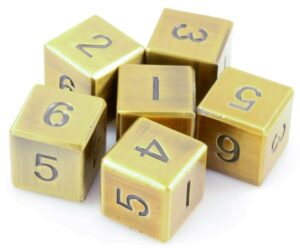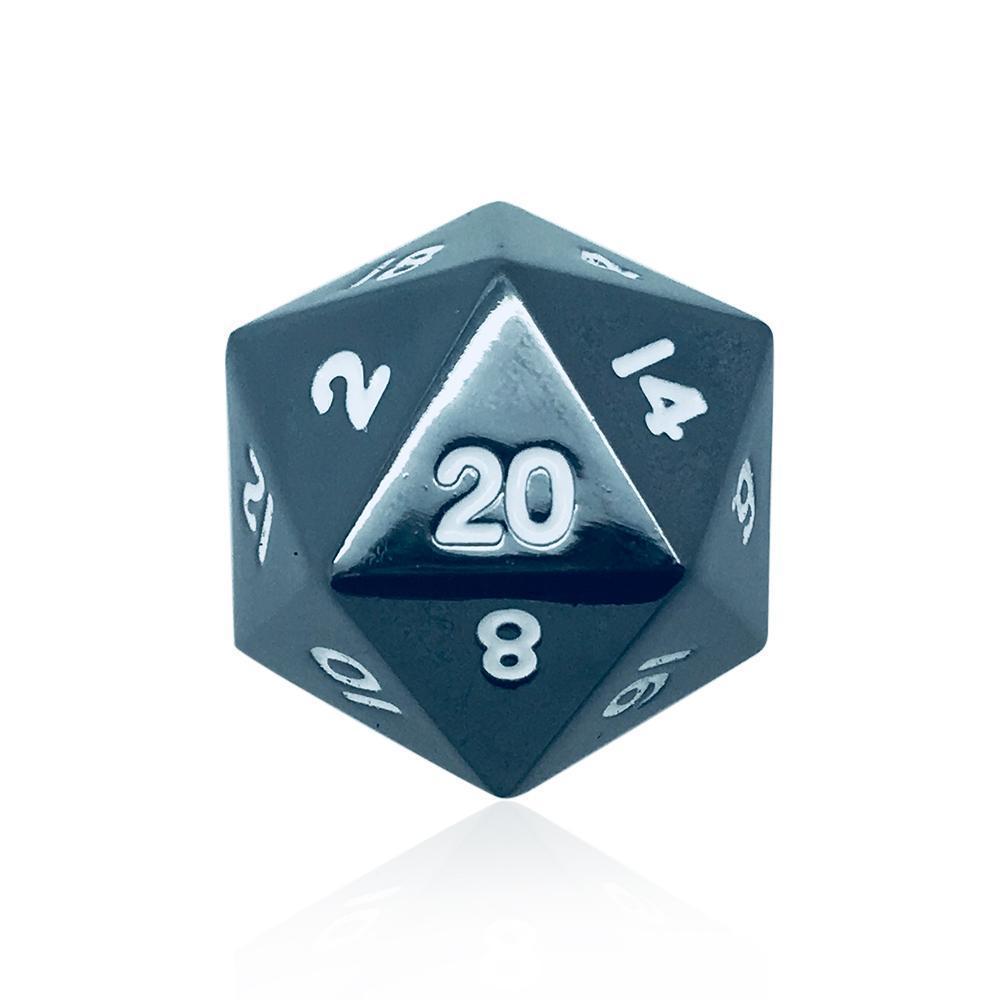I’m a new Game Master (GM) and have decided to chronicle my endeavors as a learning tool and confidence booster to other new GMs. This post describes several systems I’ve used (in playing and running games). It’s meant as a comparison between them highlighting the pros and cons of each. It also includes my view as a new GM on each one and how my players would receive them. My players are also new to role-playing games (RPGs) in general. I will cover the basics of dice and dive into each system at a high level. I will eventually dive into each system and provide more details on them.
Dice
For those new to RPGs in general dice rolls have a notation. If you want crazy details you can see them here. The basics of the notation define the number of dice to roll, which type of dice those rolled should be, and the addition of any modifiers. It follows the “NdX[+M]” where N is the number of dice, X is the number of faces on the dice rolled, and X is the addition of a modifier (if any). So If I were to ask you to roll 3 6-sided dice, I would notate that as “3d6.” Notice the lack of a modifier. This roll does not have one. If I were to ask you to roll 3d6 and add 4, I would notate that as 3d6+4. There are many differently sided dice. I’ve used 4-, 6-, 8-, 1-. 12, 20-, and 100-sided dice. Thus is the typical set used in Dungeons and Dragons (D&D). I believe this might also be called the “d20 system” as most of the dice rolled are 20-sided dice. The 100-sided dice aren’t included in this typical D&D set, but are used by GMs for loot table rolls.
Systems
I’ve used 4 systems in both playing and running games. I was introduced to the d20 system in my first gaming session ever. I found this complicated and overwhelming as a newbie. I’ve used the “Exploding d10” system when playing Vampire: The Masquerade which was definitely way less complicated and more intuitive as a player, but could be a bit overwhelming as a GM. I am currently using the d6 system in the game I’ve built and am the current GM. The d6 system is extremely easy to pick up as a player as all of the players in my game are new and it took all of 3 practice rolls to learn. As a GM, it lacks the flexibility for story flavor that the d20 system provides.
d20

This is by far the more complicated system. It involves rolling a d20 for most things which determines success of the thing you are trying to do. It is rolled for Initiative, or the turn order for combat; determining successful attacks; determining successful saves; determining successful anything… After 1d20 is rolled (see how easy it is to read now!) it is compared to some sort of challenge rating.
Challenges
In D&D, if you are physically attacking an enemy, being attacked by a magic spell, or attempting to do something difficult, you must roll 1d20 against some sort of challenge target. If you roll equal to or higher than this target number, the action is successful and you can continue (in the case of attacking, you would roll damage). If it misses, the GM describes how it misses. If you are attacked by magic or some effect you can react to, you get to roll a Saving Throw. This is essentially the same as an attack. You roll 1d20 and if you meet or exceed the target number, you take half of the damage you would have taken or suffer half the effect that would have happened. The purpose of a Saving Throw is to give you a chance to partially avoid a consequence. In any case, the GM describes how close you were to succeeding or failing. If you were attempting to jump over an enemy and barely succeeded, the GM could describe your attempt as you leaping off the enemy and slipping as you jumped landing behind him, but not as far away as you had intended. Or, if you failed a climbing check, you could fall a distance before regaining your footing. If you pass a Saving Throw for becoming afraid of something, the GM could describe you using an element of your backstory (or forging one on the spot) that steels you against whatever is attempting to make you afraid. As a GM, you have leniency and flexibility in these numbers to add detail and flavor to the scene. Steal rolls are ideal in introducing conflict, challenges, or tension. If you barely pass a stealth check, you could have someone leave the room and still be nearby forcing the players to take precaution. If the players barely pass the stealth check, you could have the enemy make a perception check to see if they notice the players. This could be rolled openly or in secret and add to the tension or challenge depending on what you decide.
Criticals
There are 2 special values on the d20 roll: 1 and 20. When a player rolls a 20, this is a Critical Success. Even if the required roll is higher than a 20, a 25 because it’s extremely difficult, a roll of a 20 is a Critical Success and indicates the player succeeded… spectacularly. The GM can get creative in describing how this seemingly impossible feat was accomplished. In combat, the dice roll total is doubled (before modifiers) to show the effectiveness of the attack.
Conversely, if a player rolls a 1, this is a Critical Failure. This indicates that, no matter how simple task may have been, the hero failed… spectacularly. This could result in a character, while attempting to stealth, tripping into a table full of pots and pans alerting anything near them of their presence, or at least to investigate the noise. In combat, it is an automatic miss and typically puts the hero at a disadvantage. Perhaps the hero lost grip of their weapon mid swing resulting in the only weapon the hero has flying through the air and landing in a corner on the other side of the band of enemies. It could also mean the weapon breaks and requires repair before it is useful again.
Pros
The purpose of the d20 system is to enhance the story telling aspect of the game and make it more dynamic. It removes a binary pass/fail result and introduces a “gray area” of effect. If you are attempting to persuade someone and are successful, only the GM knows and can alter the degree of success. Perhaps you rolled a 16 and the GM secretly knows you needed a 15. You succeeded, but not by much. Maybe the person you are trying to persuade agrees… for now and more persuasion attempts are needed later, perhaps in a moment that needs tension. Perhaps you roll a Critical Success (a 20) and the person is totally on board! Or… perhaps you roll a Critical Failure (a 1)… the person may deceive you and join you with the intention of luring you into a trap later.
The definite pros of this system is the dynamic storytelling capabilities for the GM. It may be a bit more complex (at first) but it definitely has its rewards.
Cons
The main con I have for this system is its complexity. It seems necessarily complex, but could put off new players as too complex. Having to remember which dice to roll for what actions can become overwhelming at first. As a GM, it can become overwhelming to recall what player need to roll what dice, especially as newer players rely on GM assistance in what to roll.
Exploding d10

This system, by far, is the easiest to grasp for new players and the easiest to run as a new GM while still providing dynamic opportunities for storytelling. This system uses a dice pool and a difficulty. Using your character sheet, you will have a number of points in a particular skill category (let’s use Stealth for this example). If you have 4 skill points in your Stealth ability, you would add 4 dice to your dice pool. Any abilities, modifiers, of GM specific alterations would either add or remove dice from your pool. Once you’ve determined how many dice are in your pool, you roll all of them. Anything equal to or greater than the difficulty (typically 6) is counted as a success. One success is all you typically need, unless there is a reason you need more than 1 success (perhaps the number of tumblers in a lock you are picking). Combat works the same way. You get a dice pool based on the ability you are using (Firearms, for example). You get more or less dice based on the GMs discretion (perhaps they are running through a building). After determining your dice pool you roll. For each success you deal 1 point of damage, so the more you are skilled at a particular skill, the easier it becomes (although not guaranteed) and the more damage you can do.
I’ll break the probabilities down in a later post to show you how each system is different at a mathematical level. Using the Stealth example, let’s say you are trying to sneak past some guards that are not on alert, but are nonetheless still patrolling. Let’s also say you need to roll 3 successes at 6. With your skill of 4, you can roll 4d10. If you roll 3 or more that are 6 or higher, you succeed. Otherwise, you will fail. There is still a level in success/failure that a GM can play around with at a story level to build tension or to add flavor to a scene. The GM could also just tell you to roll at a given level and not let you know how many are needed to succeed, or could tell you how many
Criticals
Critical rolls are determined by the face value of each individual die. A 10 is a success and, if you are using the Exploding d10 system, you get to re-roll it as well! If that is another 10, it’s another success, and you continue rolling it until it is not a 10, counting each 10 as another success. If you roll a 1, you negate a success. Taking the Stealth example, if you roll start with 4d10, and you roll a 5, 1, 10, and 6, you have 2 successes – 1 Critical Failure, and you get to roll the 10 again. If that is a 6 or higher, it’s another success. If it’s a 10, its another success and you get to re-roll it. Continue this, adding all successes, until you no longer have any 10s showing. Subtract Critical Failures and that’s your success level. In our example, let’s say you roll a 3 for that 10 you got to re-roll. Add up your successes (6, 10) subtract your Critical Failures (1) and your total number of successes is 1. You succeeded hiding using your Stealth ability!
Pros
The main pro of this system is player control. Each skill a player chooses to level in directly grants them a greater chance of success for any tasks that use that ability. If you lack the a skill, you are always granted 1d10, which has the chance to explode for additional successes. In this way, if you are picking a lock and need 4 successes and you do not have a Lock Picking ability, you still get 1d10 to roll. If you roll a 10, you get to keep rolling. So, while it will be difficult, it’s not impossible to pick a lock without the Lock Picking skill.
Cons
The major con I have with this system is GM control. This system is well balanced for a player actions, but lends itself to min-maxing. A player could max on charismatic abilities and let another player max on combat. This leans heavily towards meta-gaming and the type of out-of-character planning that can easily ruin a story. There are also less dramatic moments within this system. A 10% chance of exploding a die isn’t as uncommon as a 5% chance to roll a natural 20 in the d20 system.
Tiny d6

Not to be confused with the d6 System. The Tiny d6 is meant to be minimalistic. You roll 1, 2, or 3d6 and succeed of any one of them is a 5 or 6. This is the case for all rolls in the system regardless of anything else. You normally roll 2d6. Say we are using Stealth again. We would roll 2d6 and if we roll a 5 or a 6, we succeed. Otherwise, we fail. If a situation or ability provides you an advantage, you roll 3d6 instead. If it’s difficult you roll at a disadvantage at a 1d6. This extreme simplicity provides little flair when accomplishing tasks or overcoming challenges. As a GM, it feels more like “just doing my job” and less of “just me being spectacular.” In combat, rolling one or more successes deals 1 point of damage total. This is capped to 1 unless you consider additional 6s as extra points of damage. All in all, this system doesn’t lend itself to heroism and instead lends itself to gritty survival where damage is low, but so is health and abilities to heal. It might make its best use in survival instead of an adventure games.
Criticals
If something grants you an advantage, you roll 3d6. If something grants you disadvantage, you roll 1d6. In this system, there are not critical successes or critical failures.
Pros
The pros of this system is its simplicity. It is extremely easy to pick up and the type of dice and amount you need can be found in practically any board game cabinet. In my games, it typically takes about 3 minutes to explain the system to new players and for them to pick it up.
Cons
This system is very restrictive in flavor and scene progression options. Combat works without any chance of heroic moments. You deal 1 damage, or you don’t. It can become more tedious than exciting. There are elements that can be changed where additional 6s would add a point of damage, but that seems to be rather lackluster in the overall feeling of being heroic.
Thoughts
Despite it’s overly simplified nature. I opted to use the Tiny d6 system for my first GM campaign. The entire purpose of this is to introduce the wonderful world of RPGs to my wife and some of our friends who are mostly unfamiliar with this type of game. I didn’t want to scare away some of them with the initial complicated nature of the d20 system or the unfamiliarity of the Exploding d10 system. If they end up enjoying the actual game play and can get past the different dice, I might migrate the campaign to using Exploding d6 so they are at least familiar with the concept. If the players are super into it, the next game might be a more traditional d20 system! Baby steps…
